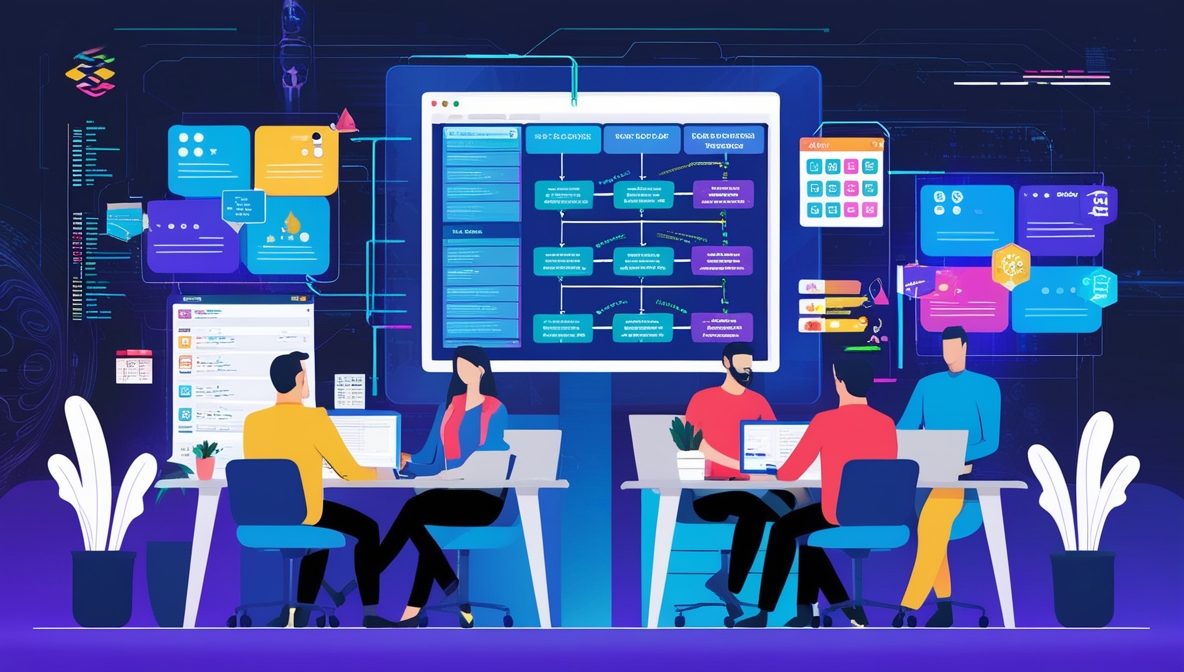This case study describes the development of an Enterprise Information System (EIS) for an ISO 9001 manufacturing firm. The system is built using rapid application development tools with the method known as extreme programming. An overview of the EIS development process, the system design goals, and a chronological narrative of EIS development are presented. Included are additional requirements and recommendations for those considering agile methods.
Agile programming techniques have revolutionized software development, providing a flexible and efficient approach that prioritizes user collaboration and rapid delivery. In this case study, we explore how these methods were applied to develop an Enterprise Information System (EIS) for a manufacturing firm, showcasing the benefits and challenges encountered during the process.
An anonymous manufacturing firm recognized for its precision and rapid delivery developed a new EIS. With annual sales between $5-$9 million and a workforce of 60-90 employees, the firm needed a system that could handle complex job estimations, real-time resource monitoring, and compliance with ISO 9001 standards. The existing system, a patchwork of outdated technologies, was inadequate for the firm’s evolving needs. The development team implemented agile techniques, specifically extreme programming (XP), to create a robust and adaptable EIS.
The existing information system was inefficient and fragmented, consisting of a Unix-based mainframe, Excel spreadsheets, and Access applications. This setup led to delays, errors, and a lack of real-time data visibility. Job estimation inaccuracies often resulted in financial losses, and the absence of a streamlined resource monitoring system made it challenging to manage labor and key processes effectively. Furthermore, maintaining ISO 9001 certification required extensive documentation and reporting, which the current system could not support efficiently.
The firm's competitive edge was at risk due to the limitations of its existing system. Misquoting projects led to significant financial losses, while the inability to monitor resources in real time resulted in operational inefficiencies. The lack of integration between systems caused redundant data entry and errors, frustrating employees and increasing the administrative burden. The pressure to maintain ISO 9001 certification added to the strain, as the current system could not adequately support the required documentation and reporting processes.
To address these challenges, the development team employed XP principles, focusing on small releases, continuous integration, and user collaboration. They began by prioritizing job estimation, creating a collaborative method for quoting new work that incorporated lessons from past projects. Next, they developed a real-time resource monitoring system to track labor and key processes, ensuring timely adjustments based on current conditions. The EIS was designed to be user-friendly, with extensive employee input to ensure cultural compatibility and minimize training time. ISO 9001 compliance was built into the system, with automated monitoring and reporting features. Throughout the process, the team used agile techniques such as pair programming, refactoring, and coding standards to maintain high-quality code and facilitate rapid development.
The implementation of agile programming techniques transformed the firm's operations. The new EIS provided accurate job estimations, reducing financial losses and improving project profitability. Real-time resource monitoring allowed managers to make informed decisions quickly, enhancing operational efficiency. The system's compatibility with ISO 9001 standards ensured seamless compliance, reducing the administrative burden. Using agile methods resulted in a robust and adaptable EIS that met the firm's needs and supported its strategic goals. The success of this project underscores the value of agile programming techniques in developing complex enterprise systems, demonstrating their potential to drive efficiency, quality, and innovation.
Main Contents
- Overview of Agile Programming Techniques: This section details the principles of agile programming, specifically extreme programming (XP), and their application in developing an Enterprise Information System (EIS).
- Challenges with the Existing System: An examination of the inefficiencies and limitations of the existing Unix-based mainframe system, Excel spreadsheets, and Access applications, highlighting the need for a more integrated and efficient solution.
- Development Process Using XP: A comprehensive narrative of the EIS development process using XP principles such as small releases, continuous integration, pair programming, and user collaboration, including specific techniques and tools used.
- ISO 9001 Compliance Integration: An explanation of how ISO 9001 compliance requirements were incorporated into the EIS, including automated monitoring, reporting features, and the impact on maintaining certification standards.
- Outcomes and Benefits of the New EIS: A discussion on the successful implementation of the new EIS, the improvements in job estimation accuracy, real-time resource monitoring, operational efficiency, and overall benefits realized by the firm.
Key Takeaways
- Efficiency through Agile Methods: Agile programming techniques, particularly XP, significantly enhance the efficiency and adaptability of software development projects by focusing on iterative development and user collaboration.
- Real-Time Resource Monitoring: Implementing a real-time resource monitoring system is crucial for managing labor and key processes effectively, leading to improved operational efficiency and informed decision-making.
- Accurate Job Estimations: By incorporating lessons from past projects, developing a collaborative method for job estimations can drastically reduce financial losses and enhance project profitability.
- Seamless ISO 9001 Compliance: Integrating ISO 9001 compliance into the system ensures seamless certification maintenance, reduces the administrative burden, and supports quality management standards.
- User-Centric Design: Involving users extensively in the design process ensures cultural compatibility, minimizes training time, and enhances user acceptance and satisfaction with the new system.
Agile programming techniques have proven highly effective in addressing complex IT challenges, particularly in developing enterprise systems. This case study provides valuable insights into how CIOs and IT leaders can leverage these methods to enhance operations and tackle real-world problems.
- Implementing Agile Practices: CIOs and IT leaders can use this case study to understand the benefits of agile practices such as small releases, continuous integration, and user collaboration. By adopting these practices, they can improve the efficiency and flexibility of their software development projects.
- Enhancing Resource Management: The case study highlights the importance of real-time resource monitoring and allocation. CIOs can apply these principles to their organizations to optimize resource use, reduce bottlenecks, and make informed decisions quickly.
- Improving Job Estimations: Accurate job estimations are crucial for project profitability. CIOs can learn from the collaborative estimation methods used in this case study to refine their own estimation processes, reducing financial losses and enhancing project outcomes.
- Ensuring Compliance and Quality: Integrating compliance requirements, such as ISO 9001 standards, into enterprise systems is vital for maintaining certifications and quality control. CIOs can use the strategies outlined in this case study to streamline compliance processes and ensure ongoing adherence to quality standards.
- Facilitating User Adoption: User-centric design and extensive user involvement are key to successful system implementation. CIOs can replicate this approach to ensure that new systems are well-received by users, minimizing resistance and training time.
By applying the lessons from this case study, CIOs and IT leaders can address common challenges such as inefficient resource management, inaccurate job estimations, and compliance issues. The demonstrative success of agile programming techniques in this context underscores their potential to drive significant improvements in enterprise IT operations.

